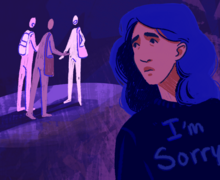Syracuse to install wider speed bumps with goal of improving pedestrian safety
Emily Steinberger | Editor-in-Chief
The city will analyze speeds at five locations through the fall to determine if they should continue or expand the program.
Get the latest Syracuse news delivered right to your inbox.
Subscribe to our newsletter here.
On Sept. 10, Syracuse Mayor Ben Walsh announced a pilot program to install speed humps, a wider version of speed bumps, in five locations across Syracuse.
The goal of the pilot program is to study the humps’ impact on reducing speeding and improving pedestrian safety, especially in parks and residential neighborhoods, according to a press release.
“We heard from residents and community groups that speeding has been an issue,” said Neil Burke, the transportation planner for the city of Syracuse. “The frequency of these complaints has increased, specifically over the lockdown periods. So we wanted to take a step here and institute some traffic calming using some techniques that we hadn’t evaluated previously.”
The new speed humps are a part of the city’s Pedestrian Safety Action Plan, which will additionally focus on upgrading crosswalks and traffic lights to increase pedestrian safety across the city. The pilot program, which includes the humps as well as signs and pavement markings, will cost about $35,000 of the total $1.54 million in federal funding allocated for the program.
The city worked with a private contractor on the project but had city crews on site to learn how to implement the humps going forward, Burke said.
Speed humps will be placed on Burnet Park Drive in Tipperary Hill neighborhood, Shonnard Street near the West Side neighborhood, Onondaga Park Drive in the Strathmore neighborhood, Stafford Avenue in the Eastwood neighborhood and North Edwards Avenue in the Eastwood neighborhood.
The city’s Department of Public Works chose each location to “best represent all the different typologies and characteristics that (the department) might see if (it) were to roll this out to a larger program,” Burke said.
The DPW will observe speeds at these five locations through the fall before compiling and analyzing the data in comparison to data collected before the installation of the speed humps, Burke said. A final decision on whether to continue or expand the program will be made in the spring.
“Slowing traffic is a surefire way to increase pedestrian safety,” Burke said. “So if we can use speed humps to do that, then we absolutely want to evaluate that and have it in our toolbox.”
While the city will wait until the spring to determine new potential locations for speed humps, Burke said that the DPW “would absolutely love to work with Syracuse University or SUNY-ESF on rolling some of these items out” on roads near the colleges.
Dawit Negussey, a professor at SU’s College of Engineering and Computer Science, said that if the university were to implement speed humps or bumps throughout the campus, it should utilize segmented bumps instead of continuous ones.
“(Segmented speed bumps) have a width that would allow trucks and buses to go without experiencing a bump, so they can speed up if it is an emergency,” Negussey said. “But for the smaller vehicles, they cannot manage to go without encountering the bump.”
Additionally, Negussey said that the heavy snow that Syracuse gets could cause difficulties when plowing roads in the winter, as the bumps may need to be removed or plows would need to proceed with caution.
Burke said the high volume of pedestrians and cyclists in the university neighborhood underscores the need for facilities that promote pedestrian safety. Most recently, the city added bike lanes to Euclid Avenue to make the road safer, but the addition of speed bumps is another step the city could take to improve the safety of pedestrians, bicyclists and motorists.
“If we’re successful and we move into a program, it’s very likely that some streets in (the SU) area would be great candidates for (speed bumps),” Burke said.
Published on September 26, 2021 at 10:13 pm
Contact Danny: ddamron@syr.edu | @dannyamron_






